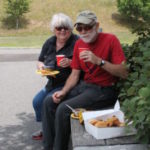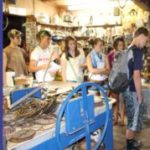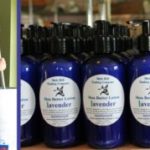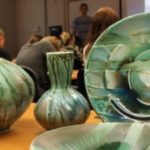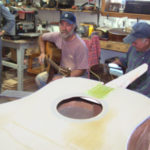Rocket Propelled Ginger Beer
As I had been dabbling in a variety of fermentation techniques which resulted in yummy food stuffs and drinks, I stumbled upon Ginger Beer. Denny and I both found it to be very soothing to the tummy and quite tasty and it was relaxing as it has an alcoholic content. And so, I assembled an array of brewing bottles with wire snaffle caps and prepared the initial must according to directions. Just a week prior to leaving for vacation, I prepared the secondary fermentation stuffs and bottled the brew in those brown bottles with wire snaffle caps. See: http://www.amazon.com/
The instructions were to leave the brew to ferment for 1 week and then taste and refrigerate if ready. I was supposed to check the brew on the day of our return.
Forgot.
So, I asked my adorable, long suffering husband to help me take the sample as I had no idea what would happen when we tried to open the bottle after I had let the brew ferment for an extra 3 days. There were 4 sixteen oz bottles.
We brought the first bottle up from the basement to the kitchen. We set the bottle onto the cabinet, and both of us held the bottle while we opened it. KABOOM! Ginger beer on the entire ceiling, the tops of the cabinets and every wall and every surface, including on us. Hmmmmm…. Cursory clean up. Now what to do with the other 3 bottles.
We elected to deal with them outside (we’re quick to catch on, aren’t we!) But my adorable — you are beginning to understand the long suffering part now, aren’t you – husband didn’t want to waste the ginger beer because we tasted the 1/2 inch left in the first bottle and it was amazingly delicious. As good as those expensive, commercial products we had tried. So we wrapped the bottle and cap in 4 layers of cheese cloth and pointed the bottle toward the chili kettle set on the ground and Denny released the second bottle. KABOOM! Bottle slipped out of both our hands, launched directly into hubby’s shin.
Instant goose egg. Lost all the ginger beer.
Third and fourth bottles. Early 4th of July. We both managed to stay out of the way of the flying wire caps which buried themselves into the earth – we ditched the chili pot and all thoughts of salvage – and we avoided the rocket launch of the bottles which landed 50 feet in the hay field beyond the house!
We have developed a different method for our secondary fermentation (using an air lock in a gallon bottle) that does not build up any pressure and will decant future batches into the bottles after the secondary fermentation is complete and refrigerate after allowing fermentation to continue only a couple of hours.
Denny says that it’s never dull around here. He’s healing nicely.
The Catfish Bottom Dweller
Contributed by Mary Kate Nicely and Joey Ellis
From the potters, to the painters, to the people who blow glass, out of all of these artisans in southwest Virginia, Rick Radman stood out the most. Radman attended Michigan State where he majored in Physical Education and Health. After graduating, Radman read a book that inspired him to ‘pay as you go.’ As a result, he used the money he saved to move to SWVA, where he built his own house in a secluded wooded area just 9 miles outside of Wytheville, free of debt.
The first art medium that Radman aspired to was pottery. He learned this craft from workshops in North Carolina. This creative side of Radman inspired him to build his own studio out of the excess wood he used to build his home. Radman had been working with pottery for fifteen years before he started working with his new art medium, metal. It took Radman five years to master welding and collect enough metal parts he needed to start his newfound hobby. Presently, Radman has been working with metals for ten years and continues to create pottery on a limited basis.
Our class at Wytheville Community College’s Appalachian Governor’s School recently visited Radman’s studio, The Stoney Fork Workshop. Radman gave us an incredible insight into his line of work. It is shocking how much work goes into one of his metal sculptures. First, he goes to scrap yards and farms to find rustic metal found objects to incorporate into his artwork. Radman goes to scrap yards so often, that his friends gave him the nickname, ‘Catfish Bottom Feeder.’ Then, he brings the parts back to his workshop to clean up the more antiquated pieces. Afterwards, Radman welds the random pieces together to make intricate moving sculptures. His most known moving artwork are the gas-nozzle beaked birds, car spring dogs, and horseshoe wind chimes. He showcases all of these works at art shows in Blacksburg, Floyd, Roanoke, at Heartwood, Southwest Virginia’s Artisan Gateway in Abingdon, and other galleries in the area. To find out more about Radman’s work, visit www.roundthemountain.org.
Radman said, “Every piece of art is different and unique. You can’t make the same piece twice.” This statement is true about his works and many other artisans’ works in SWVA. He is a passionate artisan, who never gives up. Rick Radman is a perfect candidate to introduce you to the creative culture in SWVA.
The Soap Lady
Contributed by Emily Dix and Tanner Jackson
Way back 15 miles in the country, near Wytheville, Virginia, there is a small, green, block building that will take you back in time 50 years. This is where Crystal Gillian makes her craft at Mule Hell Trading Company.
Our class at Wytheville Community College’s Appalachian Governor’s School took a trip there one crisp summer morning, to a place called Cripple Creek, Virginia. As we pulled up, as soon as we got off the bus, we could smell the strong scent of the soaps. As we walked through the door, we saw a small black-haired lady, standing on a stool stirring soap.
We could look around and see that she is very dedicated to her craft. She has over 60 products ranging from soaps to lip balms and everything in between. As we walked through the store we could easily smell the variety of soaps . . . my favorite was Milk and Honey.
We were wondering where the name Mule Hell came from. It is the name of the road where her grandmother’s house stands, which is where she lives now, and the road about two miles away from her Company. Her grandmother made soaps when Crystal was younger, but Crystal never tried to make it herself until she was 22.
When Crystal moved away from southwest Virginia, she transferred into the modern world of London, and the city-life. She married and had a child. She had many jobs but none of them ever worked out. When she moved back to Virginia, she moved into her grandmother’s 140 year old house and found the tools her grandmother used to make her soap. She also found bars of soap that were 50 years old and were still useable.
The soap interested her so that she decided she would learn how to make it. She had no help, only books and her small memories of her grandmother. When Crystal first tried to make a bar of soap, it did not work out for her. It took her three tries to finally get it right. In 2010, she started making soap to sell, but she didn’t know if that would be enough to make a living so she did other things such as work at a greenhouse and a community garden.
Her soap business took off faster than anything else and she couldn’t supply enough for the demand. She stopped doing the garden and the greenhouse and spent her time solely making soap in her house. The inventory was overwhelming and she didn’t have enough space. In 2011, she took out a loan and bought an old store, restored it and established her own company. Within three years, she has grossed over $120,000 dollars and her company continues to grow.
She has her products in many local stores and sales her soaps at festivals in southwest Virginia. If you would like to visit her, then take a trip around a curvy road surrounded by farm lands and experience the culture and the true heritage of her lifestyle. Her shop is located at 134 Francis Mill Road in Cripple Creek, VA. If you would like to contact Ms. Gillian you can email her at crystalgillian@embraqmail.com, visit her Facebook page at Mule Hell Trading Co. or you can ‘give her a holler’ at 276-621-4741.
Unexpected Art from an Unexpected Artist
Contributed by Brock Burnette, Dakotya Douglas and Jubilee Melton
The humming of a wheel spinning, the pounding thud of a slab of fresh clay against a round “bat”, and the splatter of a spinning wet creation. These are all noises Chris Lively hears every day. For twelve years, this young potter has been developing and perfecting his own pottery company in Radford, Virginia. As a member of Round the Mountain, the Southwest Virginia Artisan Network, he has his own unique style of creating his craft.
In his younger years at East Montgomery High School, he enjoyed working with clay and 3-D art. After graduating he enrolled at Radford University, in Radford, Virginia, and earned his Bachelor of Science Degree in ceramic art.
While attending college he got a job working in a ceramics studio. That ceramics studio was home to a gas fired kiln (although he prefers electric kilns) that inspired his creative design. He applies glaze to his art by spray glazing rather than the traditional way of dipping or applying it with a brush. This gives it a unique design and appearance. His work is heavily influenced by the area he and his wife (who is also his business partner) live and work in. His runny, light and dark blue glazes are influenced by local waterfalls and creeks.
Chris went back to Radford and obtained his Master of Fine Arts degree in ceramics. In college, he aspired to become a teacher of the arts. In addition to his business, Chris currently teaches a sculpting class at Radford University.
His wife, Jordan, is in charge of determining the quality of the product, at what price to sell it, and how and where to sell his pieces. The quality of his work is considered very high due to the fine porcelain clay he uses and his own formula of glazes.
Currently, his studio is at the YMCA in Blacksburg, Virginia, where he also teaches classes on how to throw clay and form pottery on the wheel. He sells most of his pottery at street fairs or at craft shows. Some of his best works are shipped and displayed at national art shows and contests, many of which either win or place highly. His work can be seen at Heartwood, Southwest Virginia’s Artisan Gateway in Abingdon, Virginia. His craft can also be found on his website www.chrislivelyceramics.com.
His art is as unexpected to him as it is to his buyers. As Chris Lively said “To put it simply, the art is in the unexpected.”
Wayne Henderson & the Eric Clapton Guitar
Contributed by Big Blue Author
We all know fine craftsmanship when we see –or feel –it: the perfectly balanced hammer, the heavy-duty kitchen mixer that whips everything poured into it for 20 years, the musical instrument that makes every player sound better than he or she actually is. It seems to be a product of patience, artistry, and perhaps a touch of genius. Sometimes it comes from simple determination, bonded with practice, practice, practice. Sometimes it is all or some of these, added to careful instruction and understanding of the process of producing the final product.
Wayne C. Henderson is a fine craftsman. He is nationally and internationally recognized for his musicianship and for his craftsmanship as a luthier – a maker of stringed instruments. In a small workshop in his back yard, he produces guitars of such high quality that the waiting list is years long and the names on that list are something of an award in themselves.
Such renowned musicians as Eric Clapton and Doc Watson have Henderson guitars. Hundreds of bluegrass and old-time musicians, who have played alongside and in competition with Wayne at fiddlers’ conventions, workshops and on tours, have acquired one. And perhaps most telling of all, so has Leah Halsey, a teenager who lives across and down the road from Wayne. Leah loves music and is justifiably proud of her Henderson guitar, and while she treats it respectfully, she does take it to campouts and outdoor conventions and, occasionally, to school, where friends and acquaintances are allowed to try it out. When asked how she got her guitar while Eric Clapton was still waiting for his, Leah will smile and shrug and will perhaps mention that after Wayne promised to start on her guitar, every once in a while she would take him one of her homemade pies It seems Henderson appreciates the craftsmanship in pastry-baking as well as in making guitars.
Henderson guitars are not flashy in appearance, though some few have more and/or individually-designed inlay as ordered by the customer. Built with older Martin instruments in mind, most have light-colored spruce tops and darker, rosewood or mahogany sides and backs. To the expert, however, they are clean-looking and elegant, with hand-sanded finishes and clean, easy action of strings on frets.
Wayne will tell you that while all aspects of making a stringed instrument are important, the secret of creating a really fine one probably lies in the parts you can’t see. The top of a six-string guitar is subject to hundreds of pounds of pressure from the strings being pulled tightly from the bridge to the tuning pegs at the end of the neck. To make the sound of the instrument being played be loud enough for the player and his audience to enjoy, the top must be as thin as possible, to increase the vibration or resonance of the strummed or plucked strings. It is easier for a luthier to work with heavier wood, since mistakes can be sanded out and things aren’t as likely to break, but heavy guitars look and feel second-rate and the sound they produce isn’t pleasing. There is a trade-off, then, between strength and resonance, and the rescue is in bracing. All guitars have wooden braces glued to the inside of their tops, and the size, shape, and positioning of those braces are what can make or break a guitar.
Wayne Henderson will tell you how he learned about bracing, and about other aspects of making a wooden instrument. Henderson grew up not three miles from where he lives now, in the Rugby community of Grayson County, Virginia. His family was small-time farmers, and he was expected to follow in the tradition, but he was also following in the path his father had taken as musician. Wayne’s father played fiddle and as a young teenager, Wayne learned to play with him, moistly chording along on a borrowed guitar.
“I decided I would try to make my own guitar,” Henderson says. “It was unheard of then (in the late ‘60‘s) for someone to make a guitar by hand. My dad said there was no way I could do it. He said you could make a tool, or you could make a door or you could make a barn, but you couldn’t make a guitar. They had to come from a factory somewhere. But I thought I could figure it out.”
Henderson admired an instrument belonging to his neighbor, E. C. Ball (who later became famous for his family’s performance of tradition gospel and ballad music, and was recorded by the Library of Congress) “It was a Martin, and I just lusted after that guitar. He’d let me play it and look at it, but he wouldn’t let me take the string off it so I could get a good look inside,” Henderson recalls. “It was years later, that I heard about a fellow who was trying to repair an old Martin and I went to see it and could finally get a look at what’s inside one.”
Meanwhile, Henderson’s first attempt at a homemade guitar literally fell apart. After working on it in his spare time for most of a year, he had an instrument that looked pretty good, but when the weather turned hot and humid, the rubber cement he’d used to hold it together, gave out. “I guess my dad saw that I was pretty low about it, “Wayne says. “He told me he’d take me to see Albert Hash, to get some idea of how to make a real instrument.”
Albert Hash had been a fiddle-player in his youth, and had handcrafted a fiddle for his own use. The artistry of that instrument combined with Hash’s skill as a fiddler had made him well known in the region, but he had set it all aside when he settled to raise a family and work in a factory. During their visit, Wayne remembers Hash bringing out the fiddle and playing some tunes for him, and thanking the Hendersons for reminding him of how much he enjoyed making music. In exchange, Wayne says the contact with the generous, genuine man and the beautifully crafted fiddle unlocked several secrets for him: information about woods and “Weldwood” glue and the idea that a real instrument could be made at home, by hand.
Wayne still has the next guitar he made. He gave it a number, “1,” and he’s numbered every instrument he’s completed since. “It still plays pretty good,” he says of that first guitar (The first that stayed together, that is.) “It looks sort of rough – most of the work was done with a pocketknife.” He smiles with a combination of confession and pride.
It was with guitar #7 that the next piece of Henderson’s puzzle was solved. While still a teenager, his grandfather passed away and Wayne began spending the nights with his grandmother, whose house was a short walk down the road from his parents’. “She was afraid to be alone at night, so I’d go down there after chores every night and stay,” Wayne explains. “She didn’t get much television or anything, so I had nothing to do but either play my guitar or work on one. I’d carry the pieces down there and work at night. I’d been working on Number 7 for a long time, months and months, because I was adding a lot of fancy inlay and stuff. It was the prettiest one I’d made so far.”
Henderson explains that a neighbor came to visit at his grandmother’s house one evening, bringing a friend with him. That man asked to see Henderson’s guitar. “He played it for a long time,” Wayne says. “He could play good, and sing. He sang Hank Williams tunes, mostly.” Before he left, the man asked what Wayne would take for the guitar. Wayne, who had sold guitars number 2 – 6 to area musicians and friends for about $40 each, did not want to sell this one. He had labored long and carefully to make this one his best so far. So, not to be rude and simply reject the man’s question, he blurted out a price that he was sure was so high, no one would ever take him up on it. “Five hundred dollars. You know, back then, $500 would buy a pretty good used car. And I needed a car.”
The men left Wayne’s granny’s house, but later, the stranger returned alone. Again, he came in, asked to see the guitar, and spent the evening playing and singing. As he got up to leave, he said simply, “Well, I believe I’ll take it.” Then he pulled five one-hundred dollar bills from his shirt pocket, handed them to Wayne, and left.
Wayne says that he was stunned by the amount of cash he had in his hand – more than he might make as profit from a year of farming. “It come to me then that a person could make a living, making guitars,” he said. It was an idea that was so foreign to the time and place, that it took a while to settle in. Once it did, though, it never left.
Instead of buying a car with the money, Henderson bought some woodworking equipment and supplies, and began making guitars seriously. “I’ve been behind (in filling orders) about ever since,” he adds.
Wayne Henderson is a generous, modest man. Sitting with his in his cluttered, comfortable shop, a visitor might never guess that he’s traveled the world on performance tours, that he was named a “National Treasure,” and that one of his guitars sold at auction at Christie’s in New York for ‘way more than $500. Think of tens of thousands.
When asked point blank what he thinks makes his guitars so fine, Henderson considers carefully and then refers to the issue of craftsmanship. He’s already told us about wood and wood joints, bracing and doing every step the right way. “I guess I’m just patient.” We do not need to add, “modest.” But Wayne himself comes up with one more point. “I’m lucky because I also play music. I know what I want it to sound like, when I’m through.”
And they do.
PS Henderson guitar #7 – the first really special one that he made - has come home and now resides in the shop. Wayne Henderson will tell you that after he sold it, reluctantly, all those years ago, he and the guitar’s new owner became friends. The man, Harold Ward of Independence, Va., invited young Henderson to accompany him to fiddlers’ conventions and musical gatherings, where he introduced Wayne to other musicians and characters of all sorts. “I guess he’s sort of responsible for getting me into making music seriously,” Henderson recalls.
Wayne Henderson caught sight of that guitar for years. “Harold eventually traded it of, and I’d see it at fiddlers’ conventions, being played or leaned up against the fender of an old pickup, getting rained on. That used to bother me. Years later, somebody brought it into my shop, asking me to repair it.”
The guitar had been reduced to a sorry state by then. The front was scarred, and there was a piece of oak flooring glued to the inside, in a clumsy effort at repair. There
